MHN Announces the 2025 Excellence Awards Winners

Multi-Housing News recently announced its 2025 Excellence Awards Winners, and our 6 Corners Lofts project in Chicago won Gold in the Best Adaptive Reuse category.

Multi-Housing News recently announced its 2025 Excellence Awards Winners, and our 6 Corners Lofts project in Chicago won Gold in the Best Adaptive Reuse category.
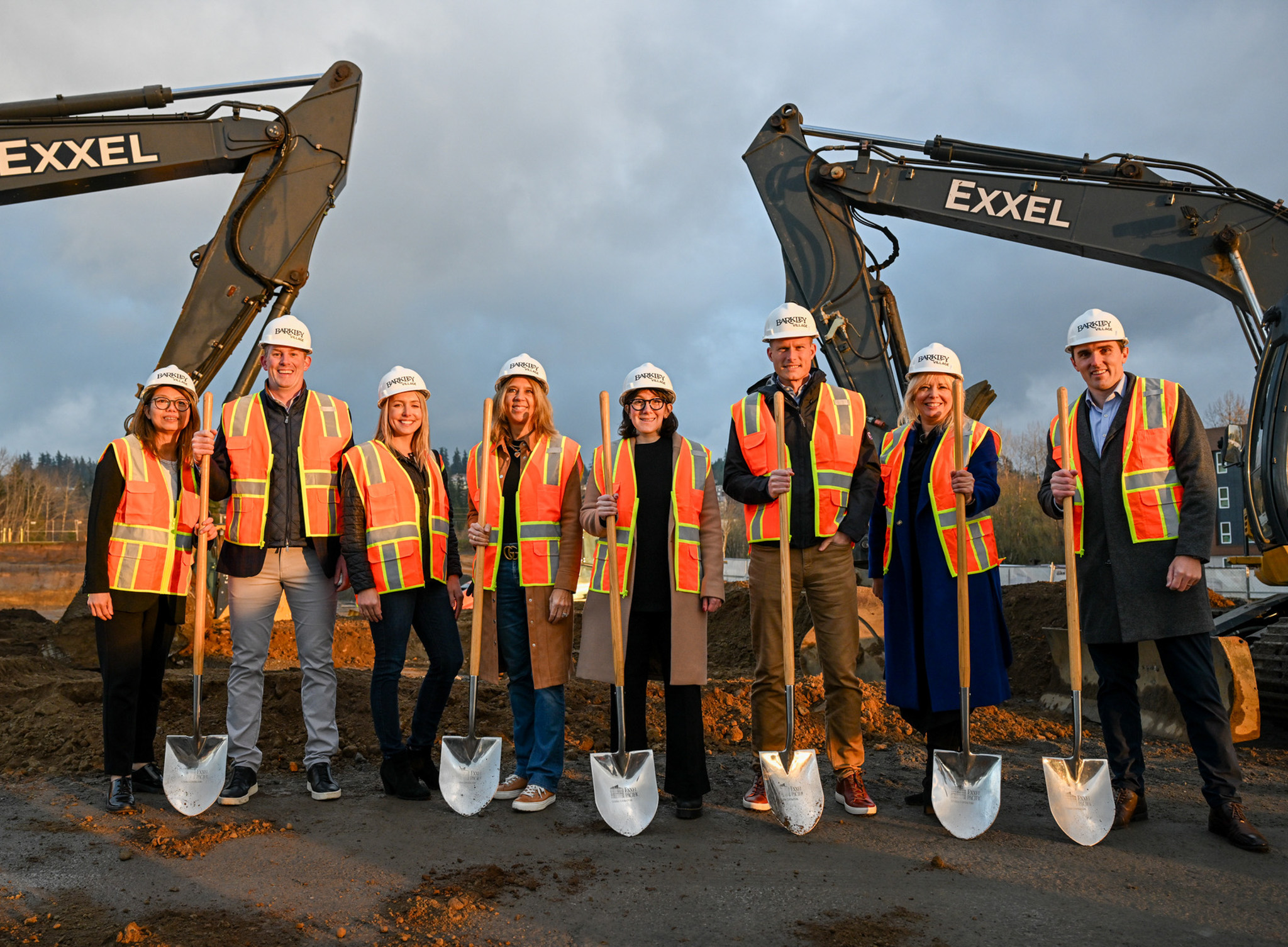
Bellingham’s newest multi-family community has broken ground! MG2, alongside Talbot Group, Realogics Sotheby’s International Realty, and City of Bellingham celebrated The Manning‘s groundbreaking earlier last month.
Located within the master planned Barkley Village development, The Manning is a new 171-unit residential complex. The building includes a gym amenity space and a large commercial space on the ground floor. Building on the master plan’s goals for a true urban village, the development seeks to draw in the community and add vibrancy to the area. Residents have direct access to dining, shopping, and entertainment options from a farmer’s market to a movie theater.
“MG2 is honored and excited to break ground on The Manning, the gateway project of the Barkley Village master plan. This building has been designed to show resiliency and timelessness, reflecting the Talbot Group’s own roots and commitment to Bellingham and the Barkley Village community.” – Jooyeol Oh, MG2 Principal
MG2 Architect Rebecca Thompson joined the project team on-site to celebrate this milestone.
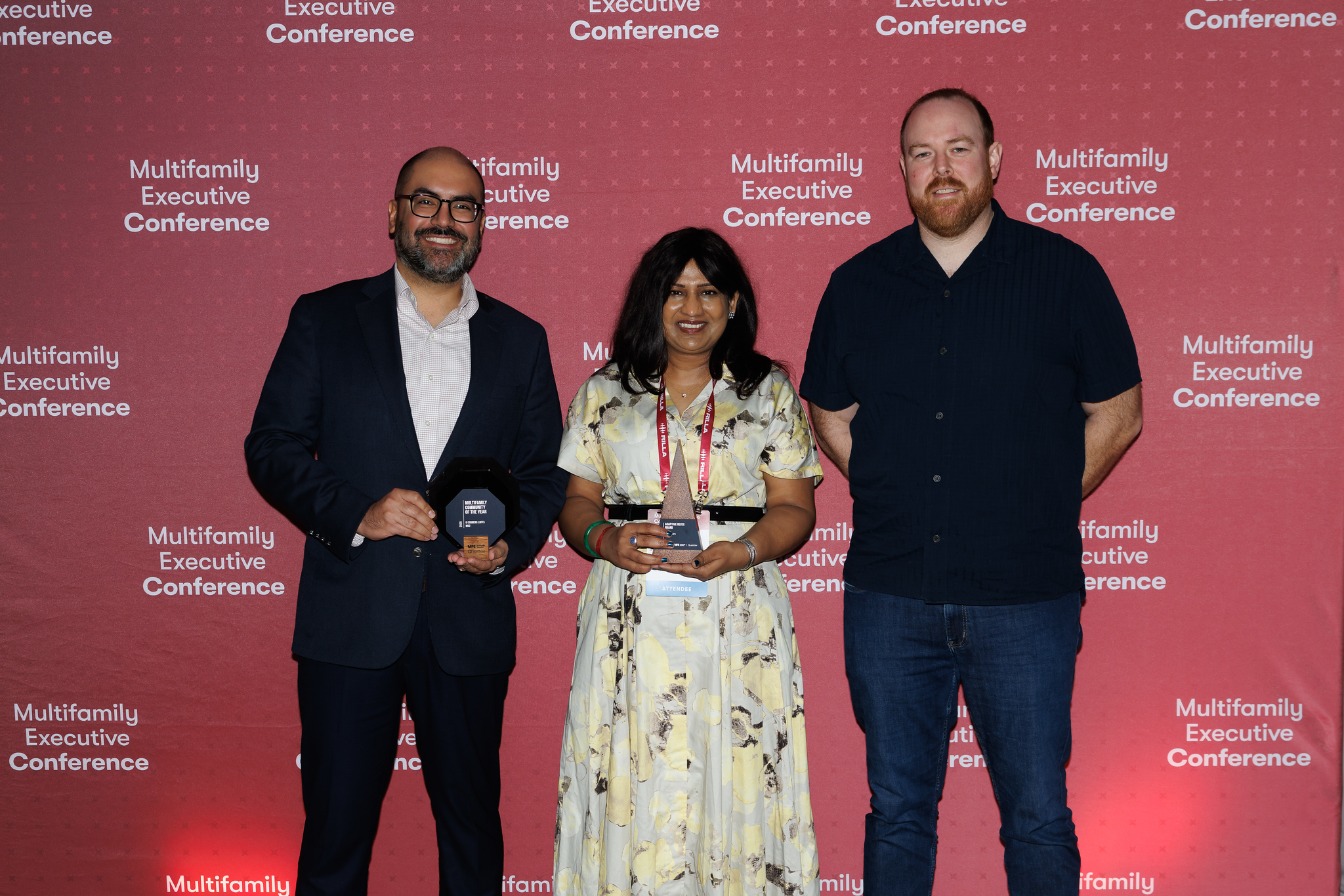
Multifamily Executive has announced its 2025 MFE Awards, and our 6 Corners Lofts project in Chicago, IL won in the Adaptive Reuse category!
MG2 Principals Felipe Romero, Meghana Joshi, and Eli Hardi accepted the award at a breakfast ceremony during the Multifamily Executive Conference in Newport Beach.

Camino Colibri, a 34-unit affordable housing community, was designed for agricultural workers in Southern Oregon. Developed in response to the 2020 Almeda Fire—the most destructive wildfire in Oregon’s recorded history—the project supports families displaced by the loss of more than 2,600 homes across southern Oregon. MG2 partnered with local organizations to create a multifamily complex that brings residents together into shared spaces reflective of their values.
Working closely with CASA of Oregon and Coalición Fortaleza, the design team listened intently to local voices that helped to inform key decisions, including site configuration, shared spaces, unit layouts, and interior features. Open kitchens were prioritized to accommodate family cooking and gatherings. Residences were designed to maximize natural daylight and include balconies and patios that connect to outdoor areas. Windows face the playground, allowing parents to keep an eye on their children while cooking.
Camino Colibri is made up of three residential buildings bordering a shared lawn, playground, and communal garden—spaces intended to encourage daily interaction and social connection. The community building includes meeting spaces, a shared kitchen, a covered patio, outdoor barbeques, and a basketball court.


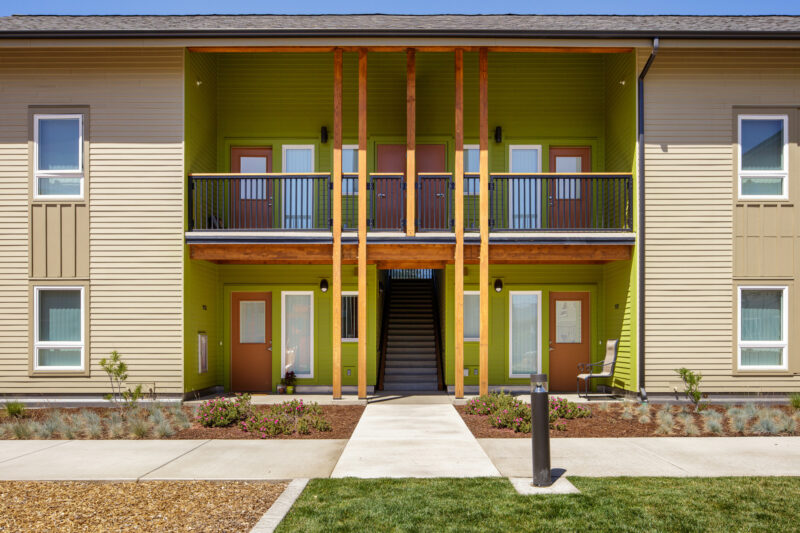
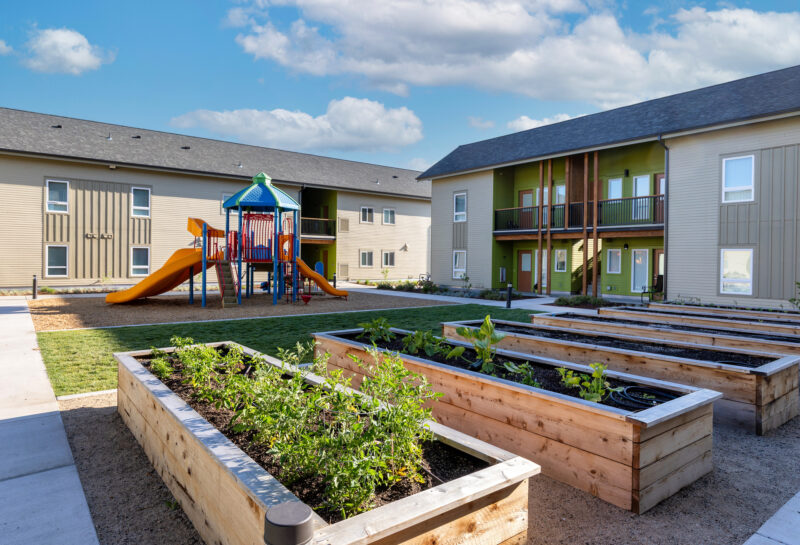
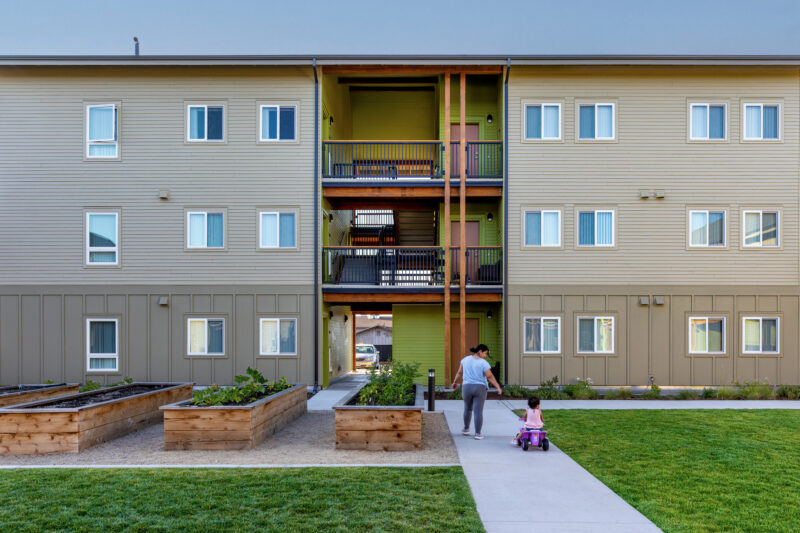
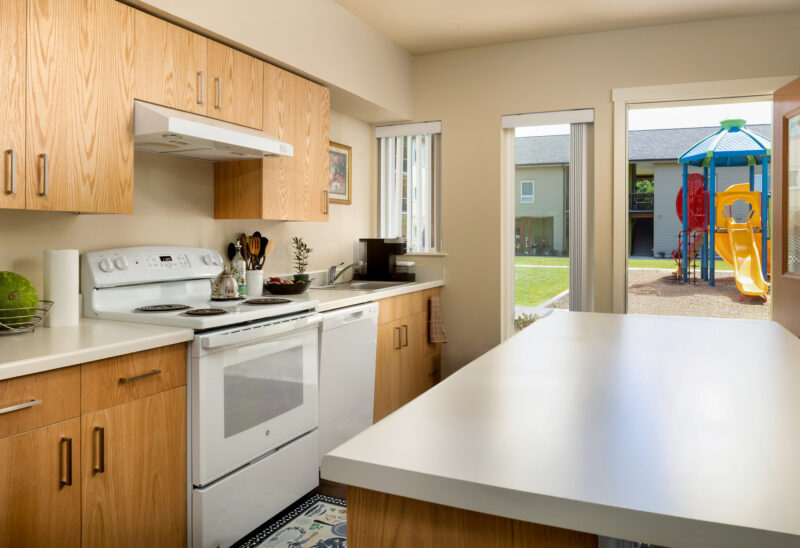
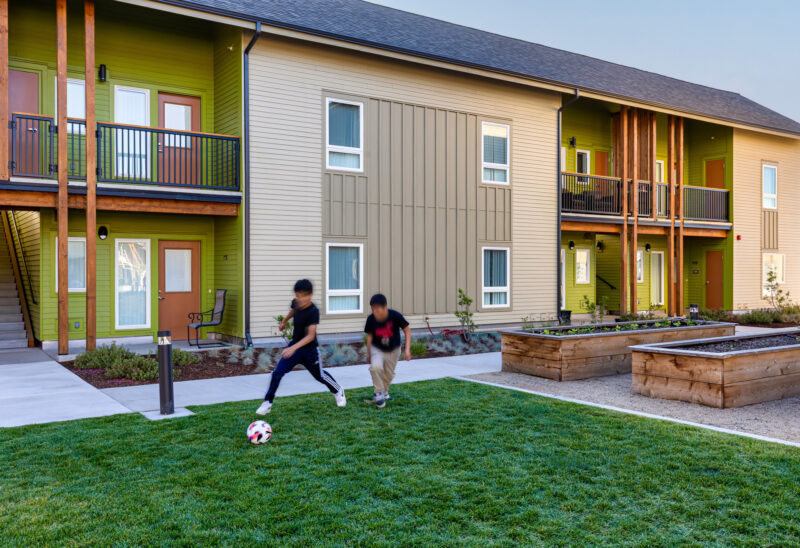
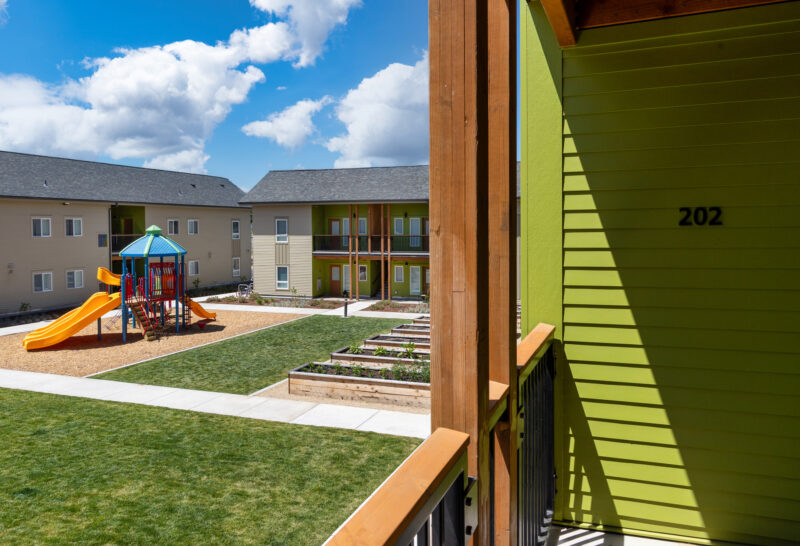
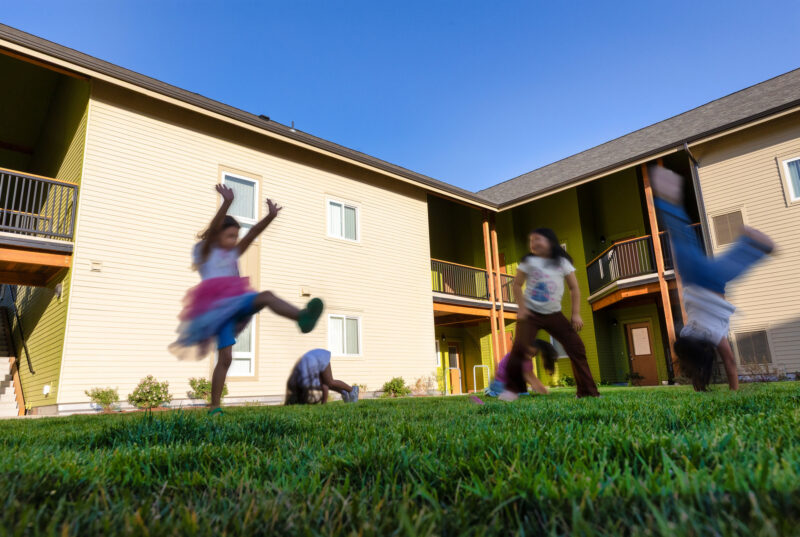
The name Camino Colibri—or “path of the hummingbird”—was chosen by the community. Representing resilience and the residents’ connection to agricultural work, the hummingbird is featured in two larger-than-life murals on the development’s exterior, visible from the sidewalk.
Camino Colibri addresses a need for affordable housing in the region and reflects MG2’s collaborative, community-informed approach to design.
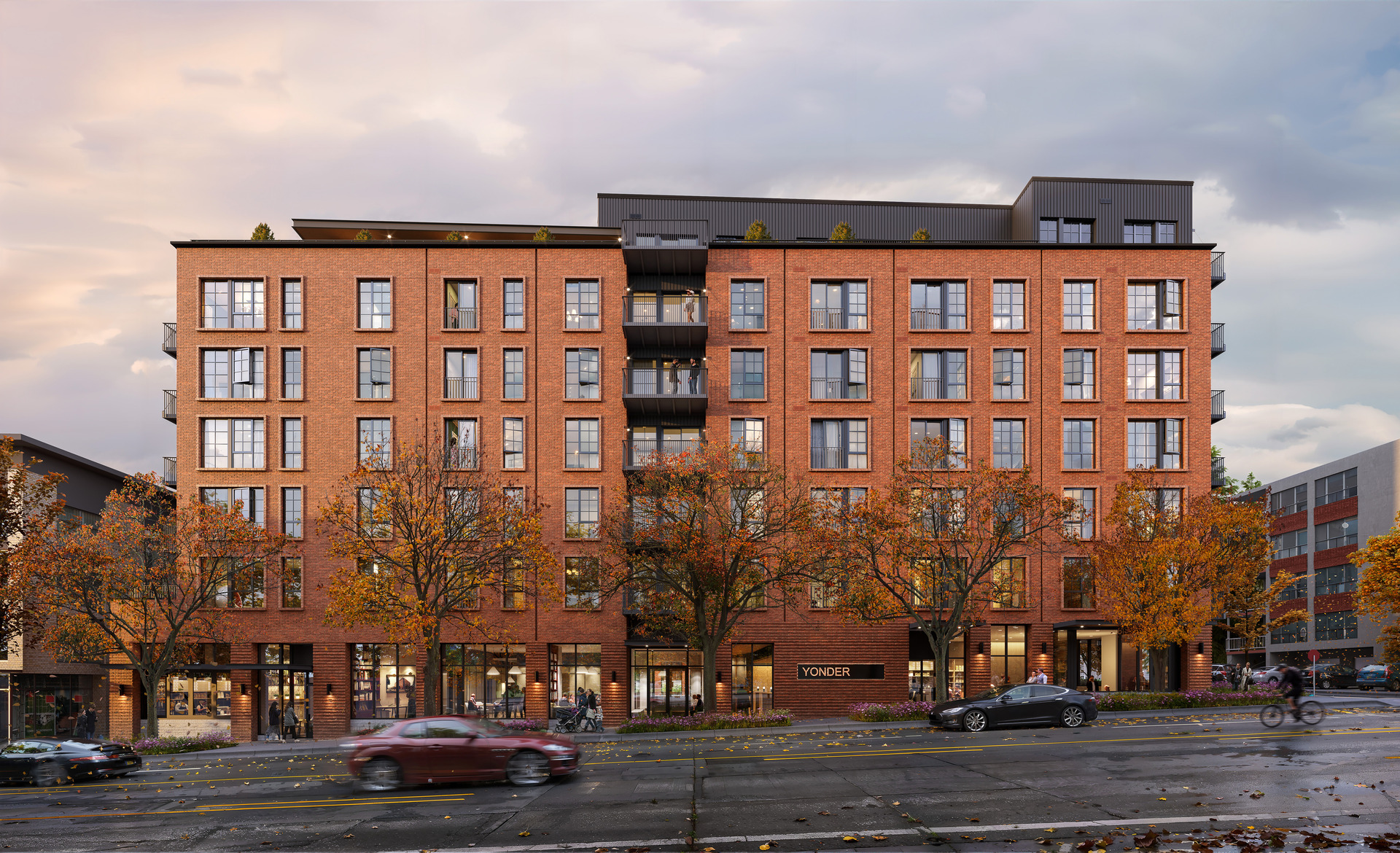
In the heart of Seattle’s vibrant Fremont neighborhood, at the crossroads of Stone Way and Bridge Way, a new seven-story development seamlessly blends modern design with practicality. Anchored by two retail spaces at street level, the building boasts a wealth of shared amenities, including a central courtyard with a trellis adorned BBQ area and a rooftop deck that overlooks the bustling Stone Way.
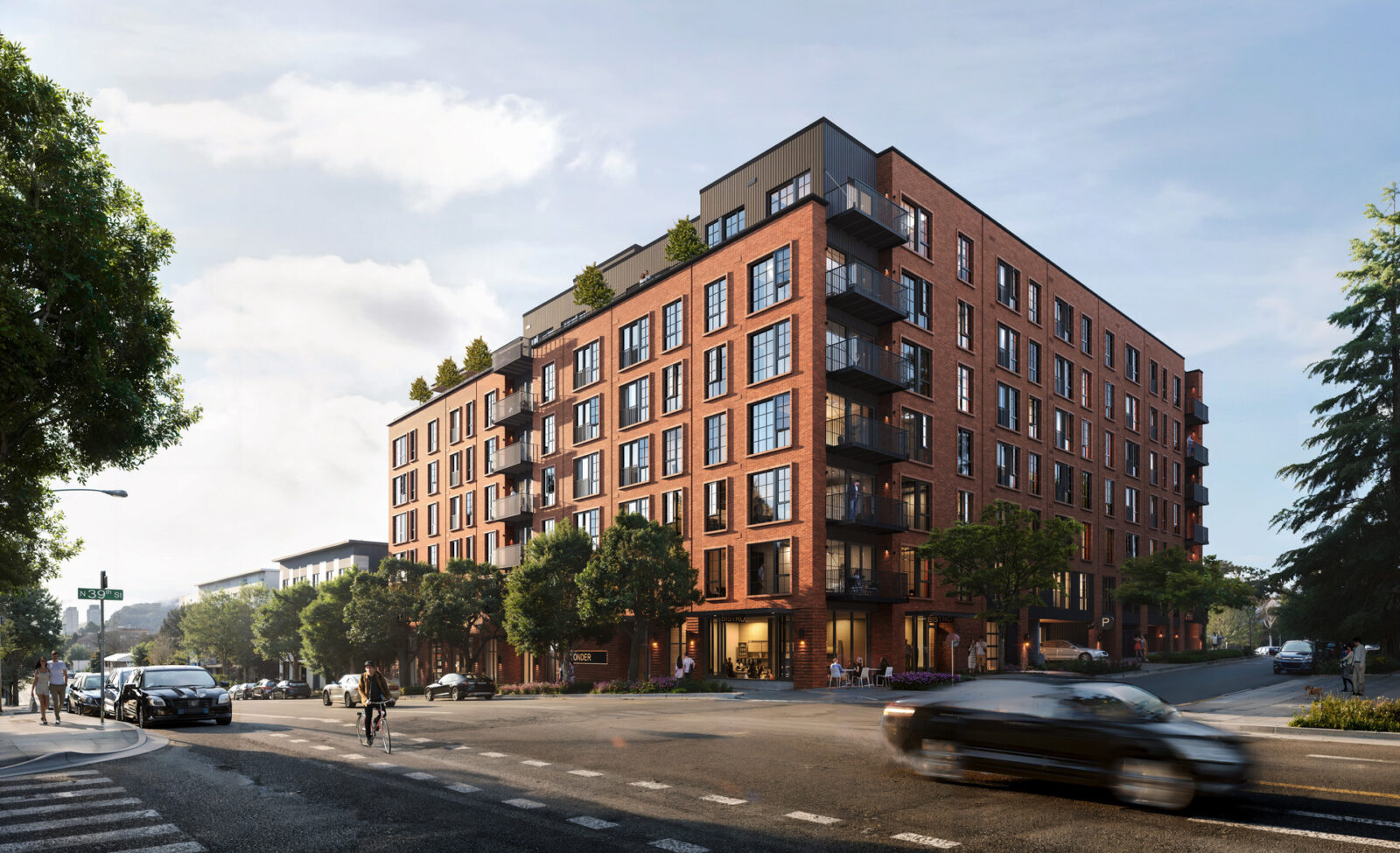

First Light, a 48-story mixed-use high-rise—retail, office, and luxury residential—in downtown Seattle, was designed as a livable piece of art. Its most prominent feature is a jaw-dropping, cantilevered rooftop pool that hovers over the city’s skyline. As Executive Architect, MG2 was charged with taking this complex project from design concept to final delivery.
At the tower’s base, “The Veil,” a permanent seven-story glass installation by sculptural glass artist John Hogan, wraps the podium in 10,000 glass discs, each individually set and angled. The local artist’s design creates an everchanging façade while also diffusing views and enhancing privacy. For residents, 20’ doors open to a lobby of polished concrete and stainless steel that features a custom Fazioli piano with more of Hogan’s glasswork integrated into the lid.

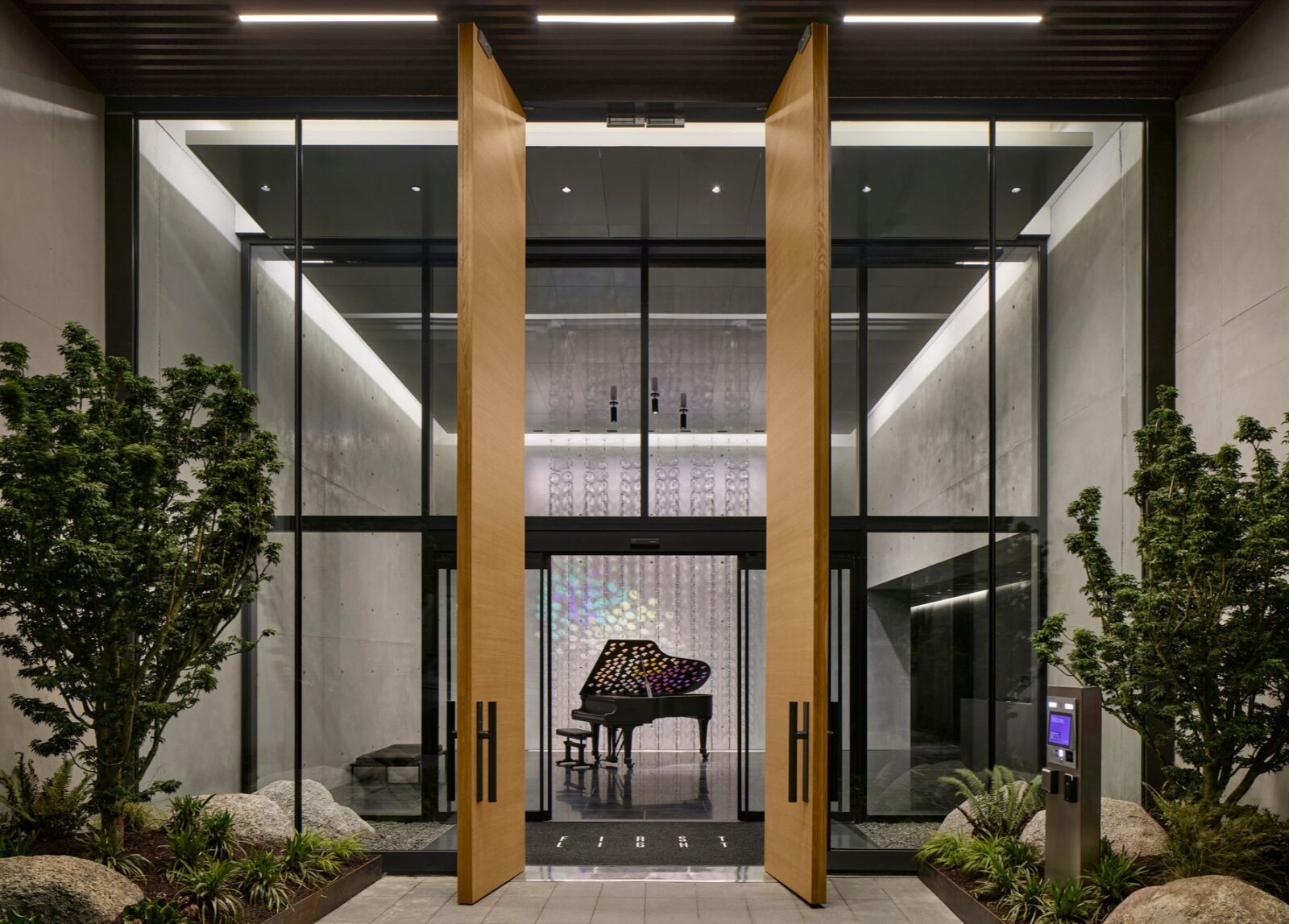
At the top of the tower and suspended over the city, the cantilevered pool deck is framed by panoramic views of downtown Seattle, Elliot Bay, and Mt. Ranier. V-shaped concrete columns support the pool deck and expansive amenity spaces, balancing engineering precision and the design’s vision to optimize structural integrity without compromising aesthetics.
The terraced clubhouse—with lounge areas, kitchen, and coworking, all with breathtaking, floor-to-ceiling views—fosters a seamless indoor-outdoor connection. A glass-enclosed, open-air Secret Garden, reached by private elevator, is landscaped with native ground covering and offers a Zen-like retreat.
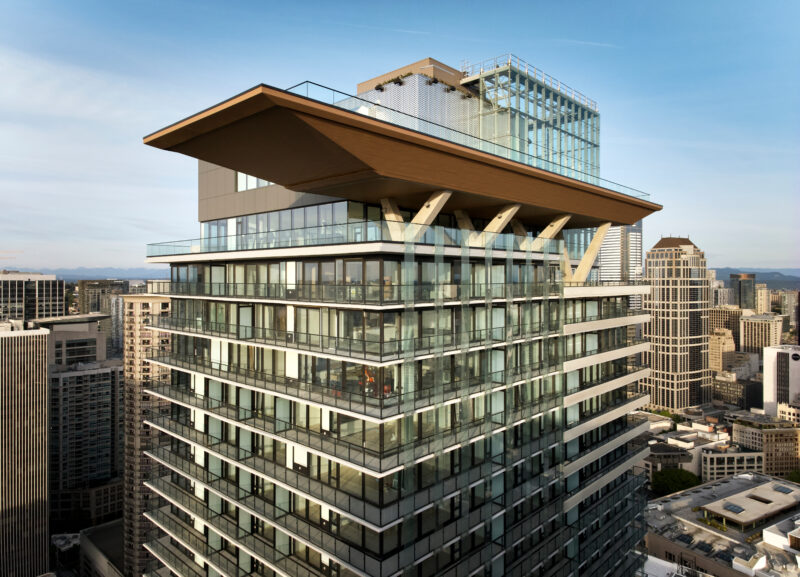
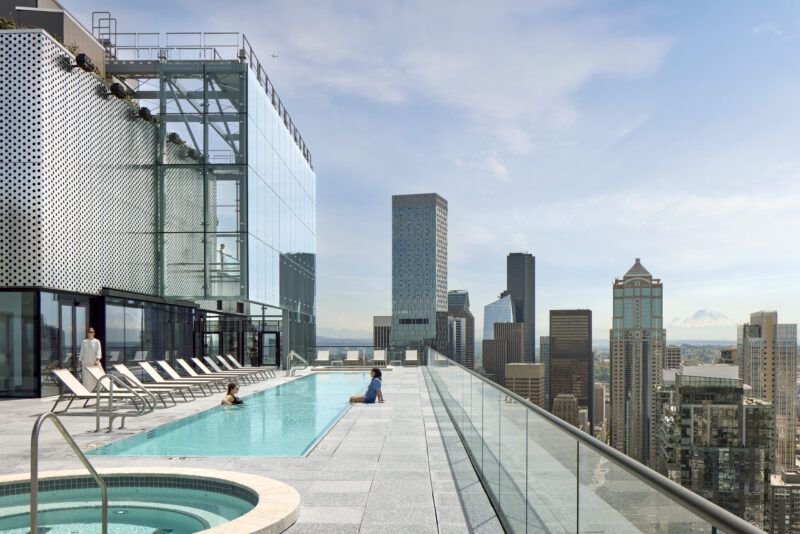
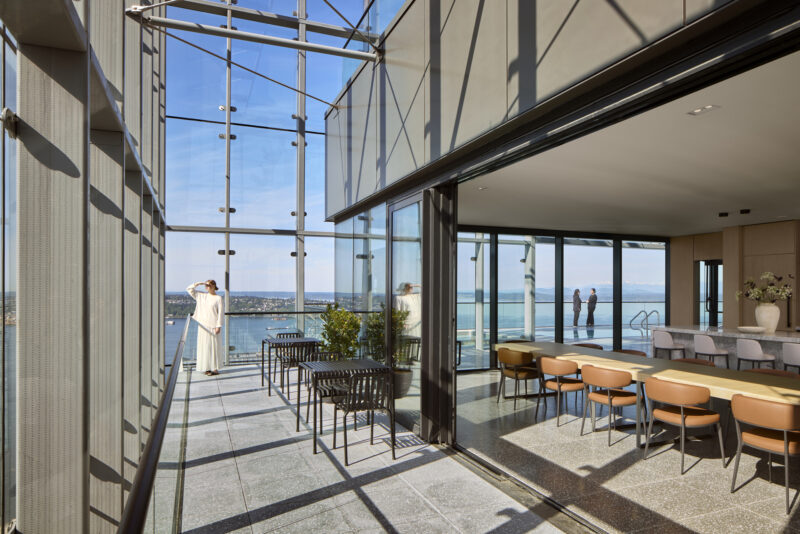
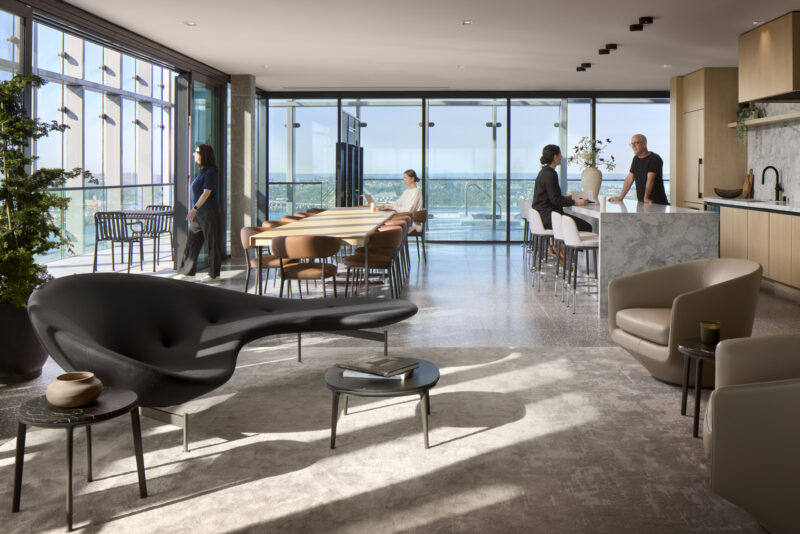

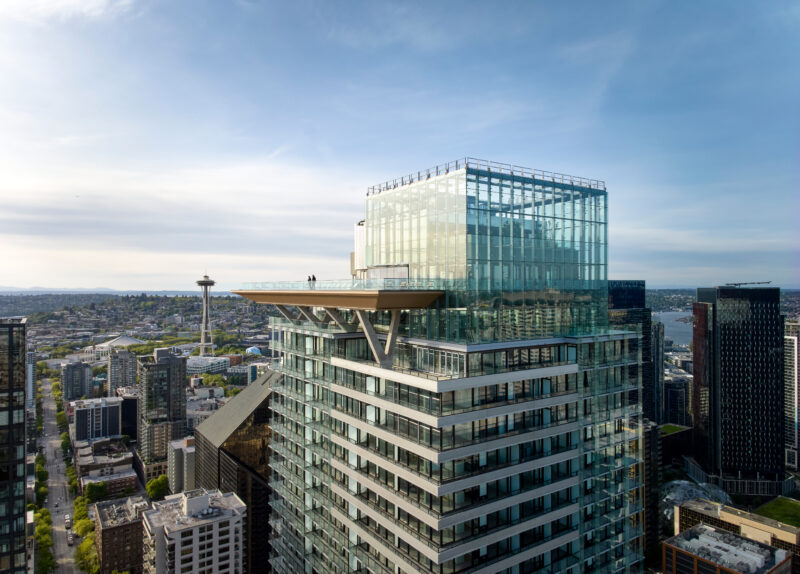
From sidewalk to rooftop, First Light is a physical embodiment of culture, a place where art, architecture, and everyday life converge. In collaboration with Westbank and James KM Cheng Architects, MG2 created a one-of-a-kind high-rise that embraces Seattle’s character and contributes a new presence to its skyline.


MG2 Principal Jooyeol Oh shared details behind the design of our 6 Corners Lofts mixed-use project in his recent article in Retrofit.
“By leaning into design and employing thoughtful adaptive-reuse strategies, MG2 successfully blends modern residential living with retail while preserving, enhancing, and amplifying iconic Art Deco elements for a 21st century sensibility. Thoughtful adaptive reuse, like 6 Corners Lofts, not only supports community revitalization but preserves neighborhood character for future generations.”

Our 6 Corners Lofts project was selected as a Finalist in the Architecture + Adaptive Reuse category of this year’s Architizer A+Awards!
In an effort to revitalize a 1938 Sears building and reinvigorate Chicago’s historic Portage Park shopping district, MG2 partnered with Novak Development to bring 6 Corners Lofts to life. MG2 Principal Jooyeol Oh preserved iconic Art Deco elements while introducing modern touches, thoughtfully connecting past and present. The innovative mixed-use project is complete with 206 residential units and over 50,000 sf of retail space.

VMSD’s Top Retail Design Firms list is one of the most important rankings in retail architecture and design. For 2025 MG2 was ranked #5 on VMSD’s list for the second year in a row! MG2 was ranked #5 on VMSD’s 2025 list of the Top Retail Design Firms!

Farmdale is an innovative farmworker housing development in Woodburn, Oregon. A replacement for a 1970s Rural Development complex, Farmdale seamlessly blends into the surrounding residential fabric by breaking up the massing to resemble a series of gabled homes. To break down the scale even further and embrace the context of the neighborhood, vibrant colors of the exterior mirror the warmth of a family neighborhood. Farmdale fosters a sense of community and connection, offering expansive outdoor spaces that include playing fields, gardens, and playgrounds.
Interior spaces are organized to stimulate spontaneous meetings between neighbors, whether it is by encouraging the use of the open stair or by treating the mailroom or laundry facilities as true communal functions. The two-story community room functions as the heart of the project, providing multi-use purpose for many occasions.




At MG2, designing for community means creating spaces that respond to the needs and voices of the people who will use them. It requires deep engagement focused on actively listening to resident priorities coupled with a commitment to accessibility, sustainability, and long-term functionality. The community engagement session with Farmdale residents was held in both Spanish and English and focused on capturing community priorities and encouraged residents to vote on various programmatic elements.

Spruce Street is a mixed-use podium building in the heart of the Yesler Terrace neighborhood in Seattle, WA, at a crossroads of zoning and architecture of varying scales. The design steps the building down to integrate this large project into the surrounding context and meet the adjacent structures. To create a pedestrian-friendly scale, the building uses façade modulation, textural changes, and patterning. Programmatic surroundings are considered, with a double-height retail space along the main street and private terraces on the ground floor along the quieter residential streets. At the heart of the building is a large central landscaped courtyard accessible from the main lobby and several indoor amenities, which include a fitness center, TV/game room, pet wash and dog run, and a sky lounge with views of Mt. Rainier.




董事 Jooyeol Oh, AIA, LEED AP, spoke with Joel Groover of ICSC C+CT about how MG2 projects, The Bowden 和 Mountlake Village, show the effects of Seattle’s future light rail expansion on the city.
Groover writes about The Bowden, “an MG2-designed mixed-use project that sits near the Overlake light-rail stop, which will connect to new stations at Marymoor Village and downtown Redmond. Construction will start this year, and the project will add 574 residential units and more than 5,000 square feet of ground-floor retail. As Oh sees it, growth of such residential projects should spur more demand for walkable retail in the neighborhood.”
Jooyeol Oh notes, “The city is envisioning that area to be a much-denser residential community, mixed with retail.”

“This ambitious project showcases the principles of adaptive reuse. The building’s evolution from a retail giant to a 206-unit residential complex, with a ground floor Target store, highlights a commitment to sustainable design,” says Cherise Lakeside, FCSI, CDT, host of ARCAT’s podcast Detailed, in her interview with Principal Jooyeol Oh about 6 Corners Lofts.
Jooyeol Oh continues his description of the project, “The primary goal of the client and community was really preserving the character and history of the building…This presented both a limitation and an opportunity to reimagine the building into a residential mixed-use building, and we were really excited about it. With its incredible bones and unique potential, we wanted to create a mixed-use building that could be distinctive and appealing to the residents and neighbors. The process was more challenging, as opposed to a ground-up brand new build, but it made the process all the more rewarding.”

“James K.M. Cheng Architects designed the 48-story project, working with local shop MG2 as the Executive Architect. First Light topped out in the fall of 2023. Since then, it’s mostly been interior work, though a few workers were out on the balconies on Tuesday morning.”

MG2 Associate Principal Felipe Romero accepted his ICSC+CENTERBUILD Leaders Under 40 Class of 2024 award at Centerbuild this week.
With over a decade of experience, Felipe has developed thoughtful, community-centered environments. Recognizing the critical role retail plays in both the economy and local communities, he has dedicated his career to designing these vital spaces.

Recently featured in CNBC, 熨斗十字路口 is undergoing a transformation into a thriving outdoor park experience. Located in Bloomfield, Colorado, the mixed-use complex will include residential, food and beverage, entertainment, and office space within a 9-acre nature park space.

MG2 Principal Jooyeol Oh spoke with Diana Mosher from the Commercial Property Executive about building conversions.
“When I think about flexible design, the word that comes to me is ‘resilience,'” said Jooyeol Oh in the piece. He continued, “Flexible design is a challenge, but it’s a challenge that we always think about.”
MG2’s 6 Corners Lofts project, a 1938 Sears building adapted into an innovative mixed-use community, is an example of that flexible design brought into practice. Original elements, like flared capital columns and terrazzo flooring, were preserved while the building was updated to bring modern amenities to residents.

MG2 Principal and design lead of 6 Corners Lofts Jooyeol Oh spoke with Multi-Housing News Associate Editor Madalina Pojoga about the adaptive-reuse process at the Sears building and the impact 6 Corners Lofts will have on the city’s Portage Park area.
“The Six Corners Shopping District has a long history as a popular and successful neighborhood shopping and entertainment destination serving the community. Preserving the character of one of its most beloved landmarks was a crucial consideration for us.
“There were three main design elements we wanted to highlight: the vernacular architecture of the surrounding brick buildings, the juxtaposition of old and new, and a celebration of the Art Deco style.”

MG2 在《建筑设计+建筑媒体》最近发布的 2024 年 200 强建筑公司榜单中名列前 20 名。

Lead designer and MG2 principal Jooyeol Oh talked with C+CT contributing editor Joel Groover about 6 Corners Lofts, a transformed historic Chicago Sears building that is now a mixed-use development.
MG2’s Community Environments team carefully preserved the building’s art deco character while introducing contemporary elements like floor-to-ceiling windows and a new top floor with luxury amenities.
“We punched floor-to-ceiling windows and added balconies and terraces. This allowed us to modernize the old Sears retail store and warehouse to a residential use while preserving its art deco character. To expand the number of residential units, we added a whole new 31-unit wing that complements the look and feel of its counterpart.”

After serving 80 years as a retail space, 6 Corners Lofts is revitalizing the Chicago area as an adaptive reuse, mixed-use development.

Mountlake Village is a mixed-use development that meets the needs of a diverse, active, and growing population. The development includes residential and retail space to invite the community in. Amenities include a coworking space, a ground-floor plaza, resident lounges, a gym, a yoga studio, a dog grooming facility, a dog run, and a rooftop terrace.



Located within the master planned Barkley Village development, The Manning is a new 171-unit residential complex. The building includes a gym amenity space and a large commercial space on the ground floor. Building on the master plan’s goals for a true urban village, the development seeks to draw in the community and add vibrancy to the area. Residents have direct access to dining, shopping, and entertainment options from a farmer’s market to a movie theater.

Beltline is a vibrant neighborhood comprised of rich history, modern luxury, and a spirited community with a personality all its own. The development holistically reflects and celebrates the historical character of the district while weaving in modern sophistication. Beltline Block includes a multi-phase mix of residential and commercial uses including four towers, each delivered in a separate phase.
